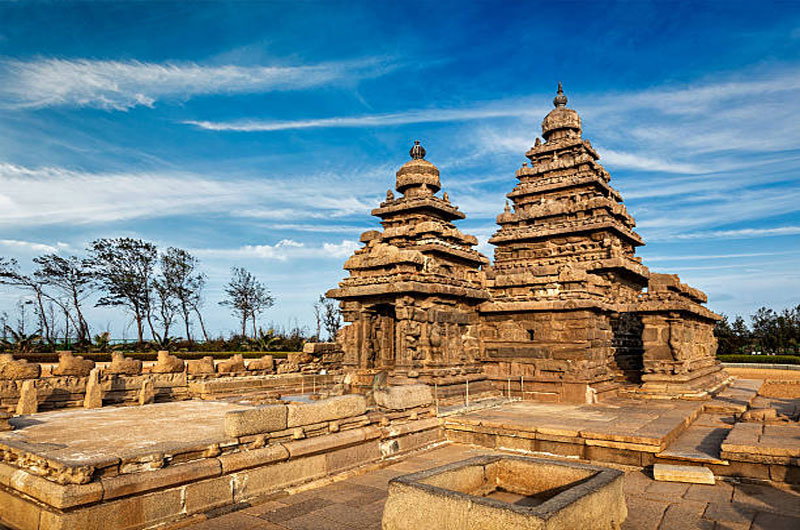
Mahabalipuram: Marvels of Pallava Architecture – A World Heritage Site
Mahabalipuram, also known as Mamallapuram, is a historic town in Tamil Nadu, India, renowned for its ancient rock-cut temples, monolithic sculptures, and architectural grandeur. Inscribed as a UNESCO World Heritage Site in 1984, Mahabalipuram stands as a testament to the artistic and architectural achievements of the Pallava dynasty. Located along the Coromandel Coast, this site attracts tourists and historians alike with its rich cultural heritage and exquisite stone carvings.
Historical Background
- Pallava Dynasty
- Flourished in southern India from the 3rd to the 9th centuries CE, known for their patronage of art, architecture, and literature.
- Mahabalipuram served as a prominent port city and cultural center during their reign.
- Architectural Legacy
- Constructed under the patronage of Pallava kings, including Narasimhavarman I (Mamalla) and Narasimhavarman II (Rajasimha).
- Blend of Dravidian temple architecture and rock-cut cave monuments, showcasing exquisite craftsmanship.
Architectural Marvels
- Shore Temple
- Iconic 8th-century temple complex dedicated to Lord Shiva, situated on the shore of the Bay of Bengal.
- Built with granite stones and adorned with intricate sculptures depicting scenes from Hindu mythology.
- Five Rathas (Pancha Rathas)
- Monolithic rock-cut temples resembling chariots, each carved from a single granite boulder.
- Represent various architectural styles and are named after the Pandava brothers from the Mahabharata.
- Descent of the Ganges (Arjuna’s Penance)
- Massive relief sculpture carved on two gigantic boulders, depicting scenes from Hindu epics and daily life.
- Shows animals, celestial beings, and divine figures, illustrating the legend of Arjuna performing penance to obtain Shiva’s weapon.
Specialty of Mahabalipuram
- Rock-Cut Architecture
- Unique example of monolithic temple architecture in South India, showcasing Pallava craftsmanship.
- Intricate carvings and sculptures depicting gods, goddesses, and mythological narratives.
- Maritime Heritage
- Historical port city that facilitated trade and cultural exchange with Southeast Asia during ancient times.
- Influence of Buddhist and Jain traditions evident in the artistic motifs and architectural styles.
Tourism Aspects
- Visitor Experience
- Guided tours available to explore the temple complexes, caves, and sculptures.
- Light and sound shows at the Shore Temple depicting the history and legends associated with Mahabalipuram.
- Accessibility
- Located approximately 60 kilometers south of Chennai, accessible via road and rail.
- Nearby attractions include beaches, heritage sites, and traditional Tamil Nadu cuisine.
- Best Time to Visit
- Favorable climate from November to February, ideal for exploring outdoor monuments and enjoying coastal views.
Impact on Locality
- Economic Benefits
- Boosts local tourism and supports livelihoods through hospitality services, guides, and souvenir shops.
- Promotes cultural tourism and heritage conservation in the region.
- Cultural Influence
- Enhances awareness and appreciation of Pallava architecture and South Indian cultural heritage.
- Preservation efforts by archaeological authorities and community involvement in maintaining historical integrity.
Preservation and Challenges
- Conservation Measures
- Managed by the Archaeological Survey of India (ASI) to ensure preservation of monuments and sculptures.
- Restoration projects to safeguard against natural weathering and anthropogenic impacts.
- Challenges
- Balancing tourism development with conservation needs to protect fragile heritage structures.
- Mitigating coastal erosion and environmental pressures on the archaeological site.
Conclusion
Mahabalipuram stands as a jewel of Pallava architecture and cultural heritage in India. Its UNESCO World Heritage status underscores its significance as a repository of ancient artistry and religious fervor. The monuments and sculptures of Mahabalipuram continue to captivate visitors with their timeless beauty and historical narratives, offering a glimpse into the rich cultural tapestry of Tamil Nadu and the enduring legacy of the Pallava dynasty.
